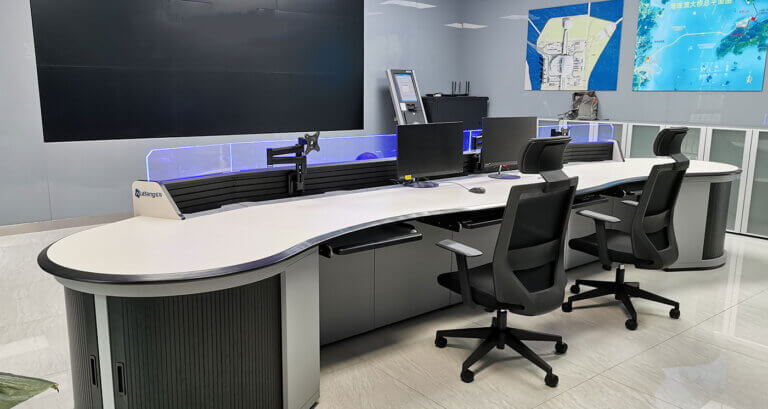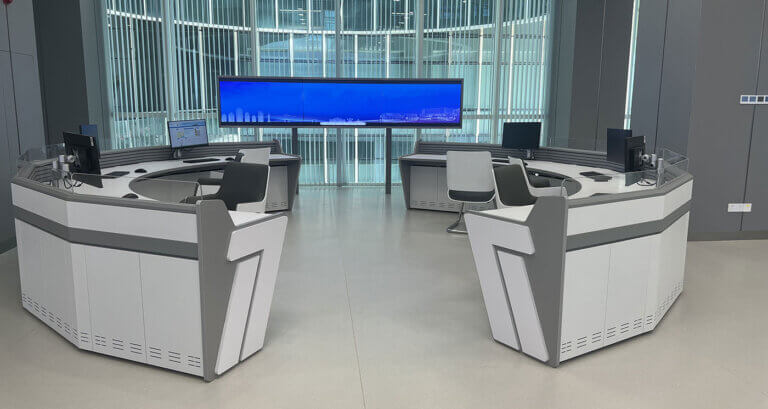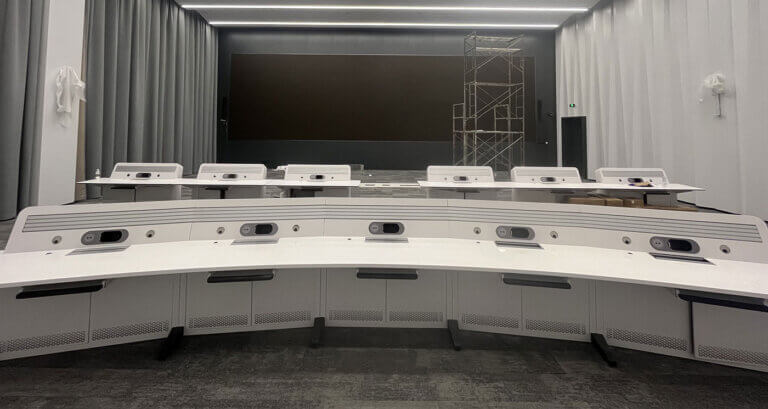
Product Categories

Hong Kong-Zhuhai-Macao Bridge Police Station

World Meteorological Center Hong Kong-Zhuhai-Macao Branch Center

Shanghai Hongqiao Airport Command Center
A control room video wall is a specialized multi-monitor setup where multiple displays are combined to create one large seamless screen. The individual displays, which are usually LCD or LED screens, are arranged in a matrix and operated by a video wall controller. This gives the combined displays the appearance of a single unified screen spanning the entire video wall.
Control room operators use video walls to monitor data feeds from various systems including security cameras, SCADA systems, traffic management software, weather radars and more. By displaying these multiple data sources simultaneously on a video wall, operators can visualize relationships and spot anomalies faster.
It monitors traffic, tracks vehicles, and responds to accidents or emergencies in real time. This optimizes traffic management and enhances passenger safety.
Essential for monitoring power grids, pipelines, and offshore platforms, providing insights into anomalies that require immediate attention.
Oversee production lines, monitor equipment status, and detect quality control issues, thereby improving productivity and ensuring product quality.
Monitor surveillance camera feeds, access control systems, and alarm notifications, helping security personnel respond quickly to threats or incidents.
There are several key reasons why video walls have become indispensable in control room environments:
A video wall allows operators to take in more critical information at a glance. Displaying multiple data feeds side-by-side gives context and improves situational awareness.
Spotting patterns and anomalies across various systems is easier when data is visualized on a large canvas like a video wall as opposed to viewing isolated data feeds.
By consolidating various data sources and visualizing relationships between them, video walls empower rapid decision-making. Control room operators can respond to events faster when they have enhanced situational awareness.
A video wall expands the amount of data that can be visually monitored and analyzed in real-time. This big data visualization enables operators to gain more insights and make data-driven decisions.
A video wall provides a common operational picture that an entire team can refer to and collaborate around. Whether it’s daily monitoring or emergency response, video walls facilitate coordination between control room operators.
The two main types of displays used in control room video wall setups are:
LCD (liquid crystal display) video walls are the most popular choice for control rooms thanks to their falling prices and ever-improving visual performance.
ased on active matrix TFT (thin film transistor) technology, LCD screens offer good brightness, contrast and viewing angles along with high resolutions.
However, the bezels between LCD panels pose a limitation for applications where a seamless display surface is preferred.
Also known as direct view LED displays, these screens contain LED modules mounted extremely close together to create seamless large screens.
While more expensive than LCD walls, LED walls offer unmatched brightness levels, higher durability and absolutely seamless visualization unhindered by any bezels. Their wider viewing angles also lend themselves perfectly for control room environments.
A complete control room video wall setup consists of the following key components:
The LCD, LED or other panels that make up the actual video wall screen comprise the display subsystem. They need to be selected based on viewing angles, brightness, lifespan and other visual performance parameters.
The video wall controller or processor takes multiple inputs and splits them to feed each screen of the video wall separately. This specialized hardware optimizes images for each display and handles video wall management functions.
Custom mounting frameworks securely hold displays in position and at the correct angle while allowing for serviceability and maintenance access. Weight-bearing capabilities are especially important for larger walls.
High-quality cabling forms the vital connectivity backbone tying the video wall components together along with the AV and control infrastructure of the control room. Cabling needs to deliver video, power and data to each screen reliably.
The various servers, computers, cameras and other systems generating the data, video and images to be displayed comprise the content sources for the video wall. These plug into the video wall controller.
With pixel pitches getting finer, display resolutions reaching 8K and High Dynamic Range enhancing contrast, control room video walls continue to evolve rapidly as mission-critical visualization solutions.
When designed and integrated properly, a video wall lets control room operators maximize situational awareness and swiftly coordinate responses to events – making them invaluable assets.
Professional video wall controllers can comfortably handle dozens of full HD displays. For example, the Barco OVL-715 can manage up to 56 screens in a single video wall. However, for extremely large walls spanning over 100 displays, using a dedicated video wall processing platform is recommended.
Both LCD and LED have pros and cons. LCD panels are more affordable for a given resolution and size. But the inter-panel bezels may limit applications needing seamless visualization. Direct view LED walls offer a seamless display surface and unmatched brightness levels. However, decreasing LED pixel pitches keep pushing their price higher. The choice depends on budget, use cases and other factors.
Rear projection video walls use DLP or LCD projectors situated behind the screens to create large seamless displays allowing easy upgradability. However, video wall cubes with embedded rear projectors tend to have deeper profiles. As flatpanel LCD and LED displays get better and cheaper, rear projection walls have diminished in popularity.
Commercial-grade LCD/LED panels and video wall components are designed for 24×7 operation. Features like redundant power supplies and fans, modular designs allowing quick servicing along with stable display electronics ensure that modern control room video walls operate reliably around the clock.
I hope this guide has helped you understand what video walls are all about and the pivotal role they play in control room environments. As the amount of data generated keeps increasing exponentially, high-performance video walls will be crucial for control teams to stay ahead of the situational awareness curve.
Do you still have any doubts about control room video wall technologies and solutions? Have you recently deployed or upgraded your video wall setup? Let me know in the comments!